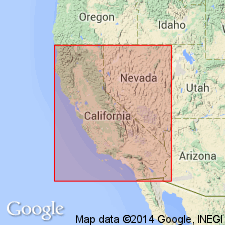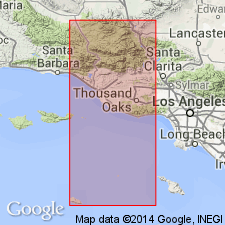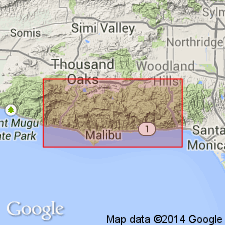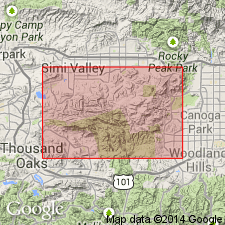
- Usage in publication:
-
- Simi conglomerate
- Modifications:
-
- Named
- Dominant lithology:
-
- Conglomerate
- Sandstone
- AAPG geologic province:
-
- Ventura basin
Summary:
Named as lower unit of Martinez group for its occurrence on flanks of Simi Hills, Ventura Co, CA. Consists of well-rounded pebbles and boulders of all sizes up to 1 foot in diameter in matrix of coarse-grained arkosic sandstone with occasional lenticular beds of sandstone (6 inches to several feet thick) in upper part. Total thickness ranges from few feet to about 800 feet on west side of faults south of Simi Valley with maximum of 1500 feet east of main fault. Unconformably overlies Chico [group]. Grades vertically and horizontally into Las Virgenes sandstone (new) of Martinez group. Apparent absence of fossils together with its great thickness in places, suggest continental origin. Age of Martinez group given as early Eocene.
Source: GNU records (USGS DDS-6; Menlo GNULEX).

- Usage in publication:
-
- Simi Conglomerate
- Modifications:
-
- Age modified
- AAPG geologic province:
-
- Ventura basin
Summary:
East of Runkle Canyon, Simi Conglomerate predominantly consists of thin- to thick-bedded, moderate to poorly sorted, pebble- to boulder-conglomerate with subordinate interbeds of medium- to very coarse-grained, poorly sorted, buff sandstone. West of Runkle Canyon formation grades into lower unit of red to pink conglomerate, sandstone, siltstone and pisolitic sandy claystone and upper unit of medium- to very coarse-grained, poorly sorted, micaceous, light-gray to white sandstone. Above sandstone unit is considered Las Virgenes Sandstone west of Runkle Canyon. Eight descriptive sections of Simi Conglomerate, Las Virgenes Sandstone and "Martinez Marine Member" (of Nelson, 1925) included. Upper part of Simi Conglomerate and Las Virgenes Sandstone contain in-situ brackish water megafossils as described by Fantossi (1955, MA thesis) and W.J. Zinsmeister (personal commun., 1973). Age given as Paleocene.
Source: GNU records (USGS DDS-6; Menlo GNULEX).

- Usage in publication:
-
- Simi Conglomerate*
- Modifications:
-
- Adopted
- Areal extent
- AAPG geologic province:
-
- Ventura basin
Summary:
Simi Conglomerate of Nelson (1925) is adopted and questionably recognized in the central Santa Monica Mountains (southwestern CA) as a thin, nonmarine conglomeratic unit; Simi(?) is correlated with type Simi Conglomerate of Simi Hills. Underlies Coal Canyon Formation (new). Age is inferred to be Paleocene(?).
Source: GNU records (USGS DDS-6; Menlo GNULEX).

- Usage in publication:
-
- Simi Conglomerate
- Modifications:
-
- Biostratigraphic dating
- AAPG geologic province:
-
- Ventura basin
Summary:
Simi Conglomerate consists of thick wedge-shaped body of interbedded sandstone and coarse conglomerates unconformably overlying Chatsworth Formation. Discovery of marine fossils approximately 30 m below top of conglomerate near mouth of Meier Canyon (Zinsmeister, 1975) indicates that uppermost part is, at least in part, marine. Gradational contact with Simi Conglomerate together with eastward thinning of Las Virgenes Sandstone suggest that Las Virgenes Sandstone represents a fine-grained facies of Simi Conglomerate. Age given as late Paleocene.
Source: GNU records (USGS DDS-6; Menlo GNULEX).
For more information, please contact Nancy Stamm, Geologic Names Committee Secretary.
Asterisk (*) indicates published by U.S. Geological Survey authors.
"No current usage" (†) implies that a name has been abandoned or has fallen into disuse. Former usage and, if known, replacement name given in parentheses ( ).
Slash (/) indicates name conflicts with nomenclatural guidelines (CSN, 1933; ACSN, 1961, 1970; NACSN, 1983, 2005, 2021). May be explained within brackets ([ ]).

